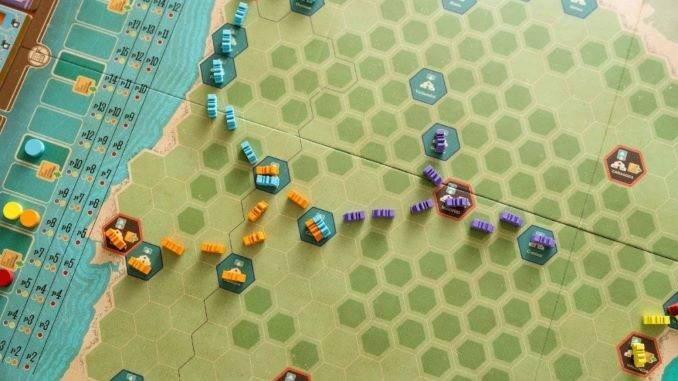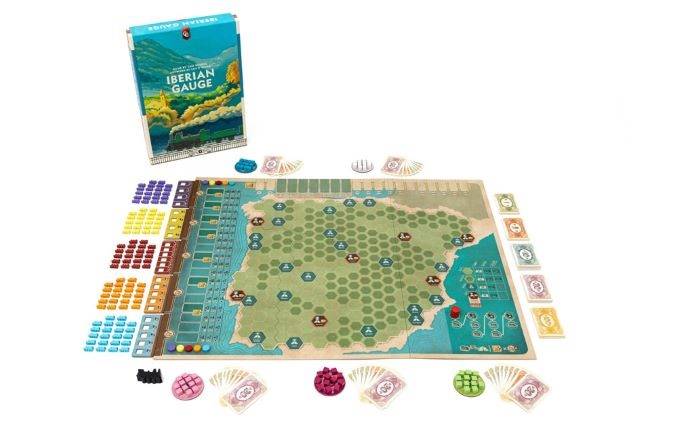Train Game Iberian Gauge Suffers from a Flawed Economy
Images courtesy of Capstone Games Games Reviews
Iberian Gauge is the third game in the Iron Rails series of train games published in the U.S. by Capstone, all of which have a strong economic component to them. Think Ticket to Ride meets Acquire, sort of, although there’s more to it than that—it’s an 18xx game, if you’re familiar with that niche, but in a much smaller and more digestible package.
The first game, Irish Gauge, designed by Amabel Holland, had players buying shares in various railways on a hex map of Ireland in an auction format, with the rail lines starting in fixed cities, and then adding up to three trains to the board on each turn. Iberian Gauge, from the same designer, maintains the spirit of the first game, but simplifies things in multiple ways, not least of which is that the auction is gone. The game has 10 rounds, four of which are investing rounds, and the other six building rounds. In an investing round, players go in turn order, buying one share at most per turn, paying the current share price or setting the initial share price (if they’re the first to buy) to the railway’s treasury, then placing one of their cubes in that railway’s share board. Once all spaces in the board are full, no more shares are available in that railway.
Building rounds are just as simple. Turn order now follows the share track comprised of all railways’ boards, going from the first shareholder in each railway down, with each player able to place one train on the board for that railway, paying the cost based on the hex type (easy, difficult, or urban/major city). You may build adjacent to any hex that railway currently occupies, or may ‘lease’ track from another railway, paying the cost shown per hex to that railway’s treasury and then building in the next urban hex after the leased line. Each railway must reach a new urban/city hex at the end of every build round or the share price drops one slot per share currently owned by a player, which often causes a railway’s share price to drop to the minimum of $4. More on that in a moment.
The game functions in a semi-cooperative way during build phases, because all shareholders in a railway have a common incentive to avoid that penalty, and thus want to ensure that the railway moves in a direction that will lead to another urban/city hex, whether directly or by lease. Building a railway also benefits investors by raising the railway’s dividend, which goes up every time the railway reaches another urban or city hex; and the stock price, which goes up whenever the railway reaches a city, and when the dividend marker passes certain thresholds on its track.

The biggest catch in Iberian Gauge is that railways need cash to keep building in every round, but have only three ways to take in fresh funds—selling shares, which is limited to four to six shares total for one railway; dividends paid to the treasury for unsold shares; and leasing track. If a railway has already sold all of its shares, and happens to be on a part of the map where other railways don’t need to lease its track, it’s toast. Its share price will drop to $4 and stay there till the end of the game—meaning investors are left with nothing, and unless they bought at the bottom, they take a loss. The game ends after the tenth round (a building round), after which players add up their cash on hand and tally the value of all of their shares, so investing in a line that turns out to be Enron Railways can cost you the game.
That dynamic, where railways can easily run out of cash if they don’t lease their track, creates one of the ways players start competing with each other during the semi-cooperative building phase. If you own several shares of one railway that’s short on cash, and maybe one share in another railway that’s nearby, you could use your build turn for the latter railway to lease track from the former, infusing some cash into it to keep it afloat. (We all sort of wished there was a bankruptcy phase, but that would have made things needlessly complicated.) It’s also why your Iberian Gauge portfolio shouldn’t be too diverse—one share in each of the five railways dooms you to finish in the middle of the pack. You have to go all in somewhere, which the limited share totals make difficult, especially with a higher player count.
That’s one of the ways where Iberian Gauge fell short for me; we played a five-player game that took way more than the box’s suggested playing time of 60 minutes, and with five players and stock purchasing in turn order rather than via auction, it’s hard for any player to get more than two shares in any railway. You do want that concentration of power, so someone acts like a robber baron (or a private equity firm) and tries to drain one railway’s treasury to keep another one going. The length of each build round was also a drag on the game, as you can easily end up with nothing to do if you’re not invested in a specific railway or two consecutive ones on the share track. We also made a huge mistake at the start of that game, setting initial share prices for each railway too low, going with $12-16 for each one, which meant several railways were cash-poor before we reached the midpoint. Starting at least some share prices in the $20+ range would have changed that dynamic substantially, and perhaps sped up early rounds where some railways didn’t sell all their shares—and if a railway with a high initial share price builds out quickly to keep its dividend and share price increasing, it’s possible one would never sell all its shares and keep funding itself.
If you’re a fan of economic games with a stock-trading element, I do still recommend Iberian Gauge, even though I think Irish Gauge has better mechanics thanks to the auction. (I haven’t played the middle game in the series, Ride the Rails, which is from a different designer.) Serious gamers might recognize this as an 18xx game, games that involve buying stock in train lines and often have playing times of three to six hours. If that isn’t your cup of tea—and it sure as steam isn’t mine—then either of these two games might make a far more satisfying entry point into this particular niche of tabletop gaming.
Keith Law is the author of The Inside Game and Smart Baseball and a senior baseball writer for The Athletic. You can find his personal blog the dish, covering games, literature, and more, at meadowparty.com/blog.